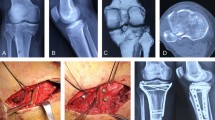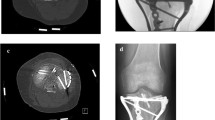Abstract
Purpose
Treatment of tibial plateau fractures is discussed. A retrospective comparative study of fractures treated with an anatomical locking plate of 4.5 mm or 3.5 mm. Our hypothesis is that the 3.5 mm plates give an equivalent hold of fractures with comparable results and better clinical tolerance.
Methods
From May 2010 to October 2011, 18 patients were operated on using a 4.5-mm LCP™ anatomical plate (group A) and 20 patients received a3.5-mm LCP™ anatomical plate (group B). Groups were comparable. One fracture was open.
Results
For the Group A, 14 patients had a follow up of 35.3 months and for the Group B, 16 patients had a follow up of 27 months. Mobility was comparable in both groups. The Hospital for Special Surgery (HSS) score was 86.4 versus 80.6, the Lysholm score was 83.6 versus 77 for groups A and B respectively. Consolidation was 3.25 months versus 3.35 months and mean axis was 183.1° versus 181.6° for groups A and B. Mechanical axes during revision were statistically different to the controlateral axes. One secondary displacement was noted in group A and one secondary displacement in group B. Group A had eight patients reporting discomfort with the material versus three in group B (p < 0.05).
Conclusion
The hypothesis is proven. In regards to the results, there is no significant difference between the two groups but the clinical tolerance was better in group B. More time is needed in the long term to better evaluate these severe fractures.


Similar content being viewed by others
References
Court-Brown CM, Caesar B (2006) Epidemiology of adult fractures: a review. Injury 37:691–697
Wu CC, Tai CL (2007) Plating treatment for tibial plateau fractures: a biomechanical comparison of buttress and tension band positions. Arch Orthop Trauma Surg 127:19–24
Ratcliff JR, Werner FW, Green JK, Karley BJ (2007) Medial buttress versus lateral locked plating in a cadaver medial tibial plateau fracture model. J Orthop Trauma 21:444–448
Zeng ZM, Luo CF, Putnis S, Zeng BF (2011) Biomechanical analysis of posteromedial tibial plateau split fracture fixation. Knee 18:51–54
Yoo BJ, Beingessner DM, Barei DP (2010) Stabilization of the posteromedial fragment in bicondylar tibial plateau fractures: a mechanical comparison of locking and nonlocking single and dual plating methods. J Trauma 69:148–155
Jiang R, Luo CF, Zeng BF (2008) Biomechanical evaluation of different fixation methods for fracture dislocation involving the proximal tibia. Clin Biomech 23:1059–1064
Mueller KL, Karunakar MA, Frankenburg EP, Scott DS (2003) Bicondylar tibial plateau fractures: a biomechanical study. Clin Orthop 412:189–195
Gosling T, Schandelmaier P, Marti A, Hufner T, Partenheimer A, Krettek C (2004) Less invasive stabilization of complexe tibial plateau fractures: a biomechanical evaluation of a unilateral locked screw plate and double plating. J Orthop Trauma 18:546–551
Gosling T, Schandelmaier P, Muller M, Hankemeier S, Wagner M, Krettek C (2005) Single lateral locked screw plating of bicondylar tibial plateau. Clin Orthop 439:207–214
Higgins TF, Klatt J, Bachus KN (2007) Biomechanical analysis of bicondylar tibial plateau fixation: how does lateral locking plate fixation compare to dual plate fixation? J Orthop Trauma 21:301–306
Hasan S, Avalon OB, Yoon RS, Sood A, Militano U, Cavanaugh M, Liporace FA (2014) A biomechanical comparison between locked 3.5mm plates and 4.5mm plates for the treatment of simple bicondylar tibial plateau fractures: is bigger necessarily better? J Orthop Trauma 15:123–129
Schaztker J (1974) Compression in the surgical treatment of fractures of the tibia. Clin Orthop 105:220–229
Gustilo RB, Anderson JT (1976) Prevention of infection in the treatment of one thousand and twenty-five open fractures of long bones: retrospective and prospective analyses. J Bone Joint Surg Am 58:453–458
Biggi F, DiFabio S, D’Antimo C, Trevisani S (2010) Tibial plateau fractures: internal fixation with locking plates and the MIPO techniques. Injury 41:1178–1182
Tegner Y, Lysholm J (1985) Rating systems in the evaluation of knee ligaments injuries. Clin Orthop 198:43–49
Ranawat CS, Shine J (1973) Duo condylar total knee arthroplasty. Clin Orthop 94:185–195
Schutz M, Kaab MJ, Haas N (2003) Stabilization of proximal tibia fractures with the LIS-System: early clinical experience in Berlin. Injury 34(suppl 1):A30–A35
Jiang R, Luo CF, Wang MC, Yang TY, Zeng BF (2008) A comparative study of Less Invasive Stabilization System (LISS) fixation and two-incision double plating for the treatment of bicondylar tibial plateau fractures. Knee 15:139–143
Estes C, Rhee P, Shrader MW, Csavina K, Jacofsky MC, Jacofsky DJ (2008) Biomechanical strength of the peri-loc proximal tibial plate: a comparison of all-locked versus hybrid locked/nonlocked screw configurations. J Orthop Trauma 22:312–316
Cullen AB, Curtiss S, Lee MA (2009) Biomechanical comparison of polyaxial and uniaxial locking plate fixation in a proximal tibial gap model. J Orthop Trauma 23:507–513
Lindeque B, Baldini T (2010) A biomechanical comparison of three different lateral tibia locking plate. Orthopedics 33:18–21
Barei DP, Nork SE, Mills WJ, Coles CP, Henley MB, Benirschke SK (2006) Functionnal outcomes of severe bicondylar tibial plateau fractures treated with dual incisions and medial and lateral plates. J Bone Joint Surg Am 88:1713–1721
Zhai Q, Hu C, Luo C (2014) Multi-plate reconstruction for severe bicondylar tibial plateau fractures of young adults. Int Orthop 38:1031–1035
Oh CH, Oh JK, Kyung HS, Jeon IH, Park BC, Min WK, Kim PT (2006) Double plating of unstable proximal tibial fractures using minimally invasive percutaneous osteosynthesis technique. Acta Orthop 77:524–530
Ehlinger M, Rahme M, Moor BK, Di Marco A, Brinkert D, Adam P, Bonnomet F (2012) Reliability of locked plating in tibial plateau fractures with a medial component. Orthop Traumatol Surg Res 98:173–179
Beck M, Gradl G, Gierer P, Rotter R, Witt M, Mittelmeier T (2008) Treatment of complicated proximal segmental tibia fractures with the less invasive stabilization locking plate system. Unfallchirurg 111:493–498
Egol KA, Su E, Tejwani NC, Sims SH, Kummer FJ, Koval KJ (2004) Treatment of complex tibial plateau fractures using the less invasive stabilization system plate: clinical experience and a laboratory comparison with double plating. J Trauma 57:340–346
Haiduewych G, Sems SA, Huebner D, Horwitz D, Levy B (2008) Results of polyaxial locked-plate fixation of periarticular fractures of the knee. Surgical technique. J Bone Joint Surg Am 90(Suppl 2):117–134
Stannard JP, Wilson TC, Volgas DA, Allonso JE (2003) Fracture stabilization of proximal tibial fractures with the proximal tibial LISS: early experience in Birmingham, Alabama (USA). Injury 34(Suppl 1):A36–A42
Lee JA, Papadakis SA, Moon C, Zalavras CG (2007) Tibial plateau fractures treated with the less invasive stabilization system. Int Orthop 31:415–418
Mattiassich G, Foltin E, Scheurecker G, Schneiderbaueur A, Kropfl A, Fischmeister M (2014) Radiographic and clinical results after surgically treated tibial plateau fractures at three and twenty two years postsurgery. Int Orthop 38:587–594
Manidakis N, Dosani A, Dimitriou R, Stengel D, Matthews S, Giannoudis P (2010) Tibial plateau fractures: functional outcome and incidence of osteoarthritis in 125 cases. Int Orthop 34:565–570
Boldin C, Finkhauser F, Hofer HP, Szyzkowitz R (2006) Three year results of proximal tibia fractures treated with LISS. Clin Orthop 445:222–229
Cole PA, Zlowodzki M, Kregor PJ (2004) Treatment of proximal tibia fractures using the less invasive stabilization system. Surgical experience and early clinical results in 77 fractures. J Orthop Trauma 18:528–535
Phisitkul P, McKinley TO, Nepola JV, Marsh JL (2007) Complications of locking plate fixation in complex proximal tibial injuries. J Orthop Trauma 21:83–91
Ricci WM, Rudzki JR, Borelli J (2004) Treatment of complexe proximal tibia fractures with the less invasive skeletal sabilization system. J Orthop Trauma 18:521–527
Lindvall E, Sanders R, DiPasquale T, Herscovici D, Haidukewych G, Sagi C (2009) Intramedullary nailing versus percutaneous locked plating of extra-articular proximal tibial fractures: comparison of 56 cases. J Orthop Trauma 23:485–492
Author information
Authors and Affiliations
Corresponding author
Rights and permissions
About this article
Cite this article
Ehlinger, M., Adamczewski, B., Rahmé, M. et al. Comparison of the pre-shaped anatomical locking plate of 3.5 mm versus 4.5 mm for the treatment of tibial plateau fractures. International Orthopaedics (SICOT) 39, 2465–2471 (2015). https://doi.org/10.1007/s00264-015-2713-y
Received:
Accepted:
Published:
Issue Date:
DOI: https://doi.org/10.1007/s00264-015-2713-y




